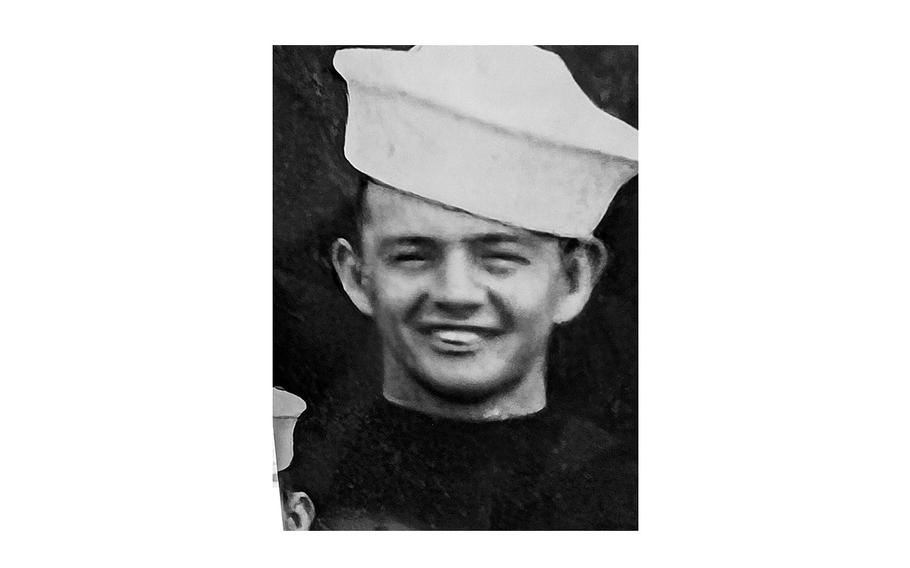
Petty Officer 2nd Class Merle Hillman, a native of Holyoke, Mass., who died aboard the USS California during the Dec. 7, 1941 attack on Pearl Harbor, will have his remains buried with full military honors on Jan. 27, 2024, in St. Jerome Cemetery, Holyoke. (Don Treeger/US Navy History and Heritage Command/TNS)
HOLYOKE, Mass. (Tribune News Service) — It was a dozen years ago that the Navy asked surviving relatives of Merle Hillman for DNA samples.
Pharmacist’s Mate 2nd Class Hillman, a Holyoker assigned to the battleship USS California, was killed in the Japanese attack on Pearl Harbor on Dec. 7, 1941. His remains were recovered, but unidentifiable with the technology of the day. He was one of 25 unknowns from the California interred with his shipmates at the National Memorial Cemetery of the Pacific in Hawaii.
The military was working to identify those remains, matching bones with the names of service members long passed.
“Then we kind of forgot about it,” said Cheryl Hillman Quinn.
But in 2018, the military disinterred those remains and began identifying them. The military was working to match the names of the long-dead but still remembered sailors, marines and soldiers to those skeletons.
Cheryl Quinn got a phone call Nov. 1. There was a match.
A few days later — on Dec 7 of all dates — the Navy met with her and her son, Brendan, in the family home. It’s the same Oak Street house where Merle Hillman lived before he enlisted in 1937.
“Pride. We finally get to give closure to our family,” Brendan Quinn, an Army veteran, said. “It’s just a huge honor to be able to eulogize my uncle.”
Hillman will have his remains buried at 11 a.m. on Jan. 27 in St. Jerome Cemetery in Holyoke, with full military honors.
Cheryl Quinn is one of two nieces who provided the sample. Her cousin — a woman named Merle, in Hillman’s honor when she was born in early 1942 — was the other.
Quinn said her father, Hillman’s older brother, spoke of Uncle Merle occasionally. Holyoke honored Merle Hillman over the years. He’d been honored at Holyoke veterans remembrances, and local Pearl Harbor survivors commemorated Hillman’s memory while they were still gathering.
Hillman is memorialized on the Courts of the Missing at the National Memorial Cemetery of the Pacific.
Read more: Holyoke sailor lost at Pearl Harbor, long unidentified, is returning home 83 years later
The family still has a letter from President Franklin D. Roosevelt to Hillman’s mother.
“But I don’t think they really had much information about what had happened to him,” Quinn said.
When Navy officials visited in December, they were able to fill in some gaps. They brought a large book with all Hillman’s medical records — physicals, dental visits — from his time in the service. The book also has photos of the remains, with wounds still evident.
A surviving veteran of the Battleship California told the Quinns that he’d last seen Merle Hillman in the galley.
Brendan Quinn pointed out that, as a pharmacist’s mate, Merle Hillman would have been below decks, tending the wounded during the attack.
Hillman’s ship was on Battleship Row that Sunday.
The California had two 5-inch guns and two .50-caliber machine guns designated as ready guns, with 50 5-inch shells and 400 .50-caliber rounds ready when the Japanese attacked.
Gun crews engaged the enemy, but their ammunition quickly ran out, the Navy said.
While sailors worked to bring ammunition up from magazines below decks, the ship was damaged by a pair of torpedoes and a bomb.
The crew was preparing USS California for an inspection, and its watertight doors were open. That means flooding was uncontrollable after the torpedoes hit.
Many of the portholes and exterior doors were also open, allowing more water to enter the ship.
California began to list to the left. Torpedo blasts had ruptured the ship’s forward fuel tanks, allowing water to enter the fuel system. The contamination shut down the ship’s electrical system, and damage control teams couldn’t work. Pumps shut down.
Between 8:15 and 9:15 a.m., Japanese dive-bombers repeatedly attacked the USS California, causing further damage.
One bomb penetrated the upper deck, ricocheted off the second deck and detonated in the ship’s interior, causing extensive damage. It started a serious fire and killed around 50 men.
The California filled with water over the next three days and eventually sank. There were 104 men killed and 61 wounded. Four California sailors were posthumously awarded the Medal of Honor for displays of heroism during the attack.
But the Navy was able to refloat California in March 1942. It was repaired and modernized over the next two years, and starting in 1944 rejoined the fight in World War II.
©2024 Advance Local Media LLC.
Visit masslive.com
Distributed by Tribune Content Agency, LLC.